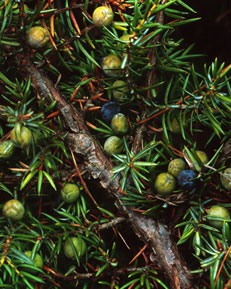
Photo © Steven Foster
Introduction
The juniper berry comes from an evergreen shrub or tree with dark green to blue-green leaves which grows to 20 feet in height.1,2 The native habitat of the juniper berry is the temperate area of the northern hemisphere in Europe, Asia, and North America.1,2 The dried, mature female cone is called the berry and is blue or reddish in its second year.3 The berry is steam distilled after fermentation or without fermentation to extract the essential oil. The berry and the oil extracts from the berry are the parts used.1 History and Cultural Significance
Juniper berry has been used as a diuretic,4,5,6 to battle bad breath5 and to enhance appetite.2 Juniper berries are used as flavoring agents in teas, gin, and alcoholic bitters.1,3 The extracts or oils are used in alcoholic and non-alcoholic beverages, baked goods, candy, frozen dairy desserts, gelatins, meat products, and puddings.1,3 Juniper berry oil is used as a fragrance component in creams, detergents, lotions, perfumes, and soaps.1 It is also used externally to ease discomfort.4 The German Commission E approved the use of juniper dried fruit or oil to relieve dyspepsia, disturbed digestion or indigestion.2,7 Modern Research
Currently there are no clinical studies available on the internal or external use of Juniperus communis. Future Outlook
As of 1998, demand for juniper berry had gone up as supply decreased.8 Another common problem is the adulteration of oils. Manufacturers may try to reduce cost by adding other compounds. This could possibly increase the toxicity of the oil and cause adverse health effects.9 References
1 Leung AY, Foster S, eds. Encyclopedia of Common Natural Ingredients Used in Food, Drugs, and Cosmetics. 2nd ed. New York: John Wiley and Sons, Inc; 1996. 2 Blumenthal M, Goldberg A, Brinckmann J, eds. Herbal Medicine: Expanded Commission E Monographs. Austin, TX: American Botanical Council; Newton, MA: Integrative Medicine Communications; 2000. 3 DerMarderosian A, Beutler JA, eds. The Review of Natural Products. St Louis, MO: Facts and Comparisons; 2002. 4 Bown D. The Herb Society of American New Encyclopedia of Herbs and Their Uses. London: Dorling Kindersley Ltd.; 2001. 5 Hocking, GD. A Dictionary of Natural Products. Medford, NJ: Plexus Publishing; 1997. 6 Duke JA, ed. Handbook of Medicinal Herbs. 2nd ed. Boca Raton, FL: CRC Press; 2000. 7 Blumenthal M, Busse WR, Goldberg A, Gruenwald J, Hall T, Riggins Cw, Rister RS, eds. Klein S, Rister RS, trans. The Complete German Commission E Monographs- Therapeutic Guide to Herbal Medicines. Austin, TX: American Botanical Council; Boston: Integrative Medicine Communications; 1998. 8 Landes P. Market report: spice imports increase. HerbalGram. 1998;42:64. 9 Bone K. Juniper berry is not a kidney irritant. British Journal of Phytotherapy.1995;4(1):47-48.
|